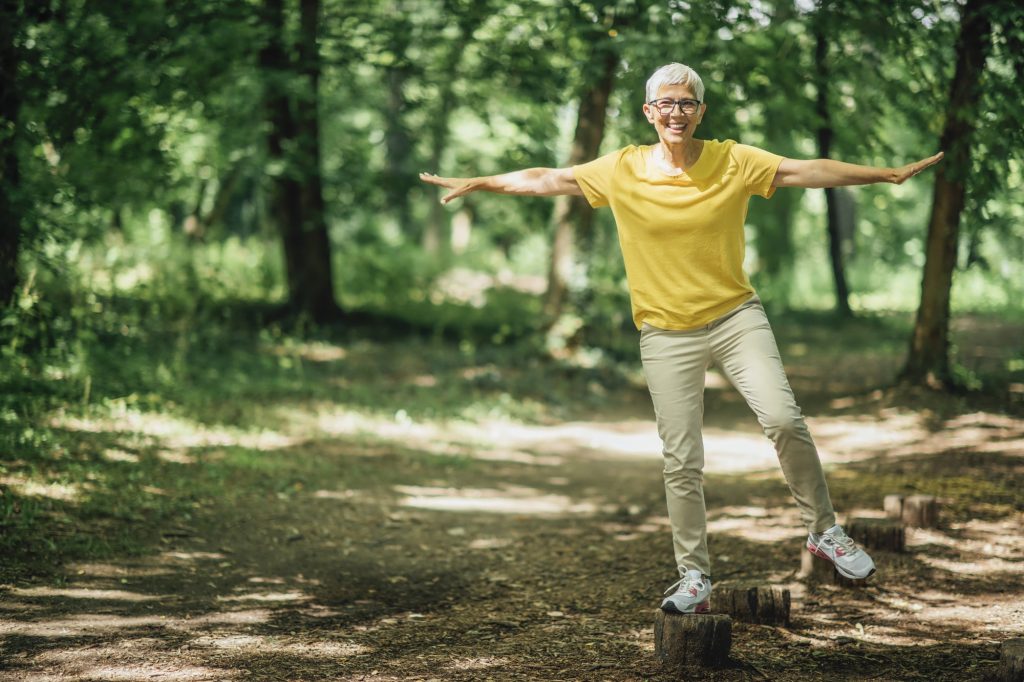By Timothy Pass, BSc (Physiotherapy)
Hello and welcome to the first of my online blogs!
Today’s topic is one of great importance among older adults – falls prevention.
One of the most common problems that community physiotherapists manage is falls risk in older adults. Falls are unfortunately very common in the 65+ age group and are a leading cause of injury and hospitalisation.
Some falls facts:
- 1 in 3 people over 65 fall each year in Australia.
- Falls account for 38% of hospital admissions in people over 65.
- The body regions most commonly injured as a result of falls are the head (26%) and the hip and thigh (22%).
- 1 in 12 hospitalisations for a hip fracture result in entry into a residential aged care facility.
Falls are associated with age-related declines in balance and leg strength, however they can also occur as a result of environmental risk factors, such as trip and slip hazards. Fortunately however, falls are preventable and reduced balance and strength can be reversible.
There are four main ways in which you can reduce your risk of falling:
1. Improve your balance and leg strength
Research shows that having strong legs and good balance will significantly lower your falls risk. Staying physically active is vitally important for maintaining your balance and strength, and therefore reducing your risk of falling. A physiotherapist can advise you on the most appropriate exercises for you.
2. Look after your general health
Generally speaking, the healthier you are, the lower your falls risk. However, there are several specific health factors that can affect your risk of falling, such as:
- Medications: Some medications can increase your risk of falling, including some types of blood pressure medication, some painkillers and some sleeping pills. If you are worried a medication may be affecting your balance, consult your GP.
- Optical: Vision impairments increase your risk of falling because they affect your ability to identify obstacles that may cause a trip or a slip. A regular eye exam can help monitor your vision and identify any changes.
- Diet: Vitamin D and calcium increase your bone strength and have been scientifically proven to reduce the risk of both falls and fractures. These can be found in dairy and green vegetables, however they can also be acquired through supplements (speak to your GP or pharmacist). Protein will help maintain muscle mass and strength, and therefore lower your falls risk.
- Mind: Staying mentally active can help improve your alertness and your reactions to hazards. Keep your mind busy through activities such as reading, puzzles or learning something new. It is also important to stay connected socially.
3. Modify your home environment
Several hazards can exist within the home, potentially causing either a ‘trip’ or a ‘slip’. Removing these hazards where possible, or at least increasing your awareness of them will help reduce your risk of falling.
- Trip hazard examples: Rugs, mats, cords, cables, steps, uneven paving, loose objects, pets.
- Slip hazard examples: Wet tiles, socks, shoes with poor grip.
4. Use assistive devices if needed
- If required, use a walking stick, frame or walker. Your physiotherapist can advise you on the most suitable walking aid for you.
- Handrails can be very helpful in areas of higher falls risk, such as steps, the bathroom, shower and toilet. An occupational therapist can assess your home and make recommendations regarding these.
- Ensure you wear suitable footwear that fits you correctly and is comfortable. Socks without non-slip soles can be dangerous on hard floors. A podiatrist can advise you on the most suitable shoes for you as well as general footcare.
Falls are common and can have serious consequences. However, the good news is they can be prevented. By following the steps above, you can be confident that your risk of falling will be significantly lower.
*Please note the above advice is general and for informative purposes only. For falls prevention management and advice specifically tailored to your needs, please contact us to book an appointment.
References:
AIHW: Pointer S 2019. Trends in hospitalised injury due to falls in older people, 2007–08 to 2016–17. Injury research and statistics series no. 126. Cat. no. INJCAT 206. Canberra: AIHW.
AIHW: Bradley, C. (2013) Trends in Hospitalisations due to falls by older people, Australia 1999-00 to 2010-11, Injury Research and Statistics no. 84. cat. no. INJCAT 160. Canberra: AIHW.
Australian Institute of Health and Welfare 2018. Hip fracture incidence and hospitalisations in Australia 2015–16. Cat. no. PHE 226. Canberra: AIHW
AIHW (Australian Institute of Health and Welfare) 2019a. Disease expenditure in Australia. Cat. no. HWE 76. Canberra: AIHW.
Thanapluetiwong, Saran MDa; Chewcharat, Api MDb; Takkavatakarn, Kullaya MDb; Praditpornsilpa, Kearkiat MDb; Eiam-Ong, Somchai MDb; Susantitaphong, Paweena MD, PhDb,c,∗ Vitamin D supplement on prevention of fall and fracture, Medicine: August 21, 2020 – Volume 99 – Issue 34 – p e21506 doi: 10.1097/MD.0000000000021506

